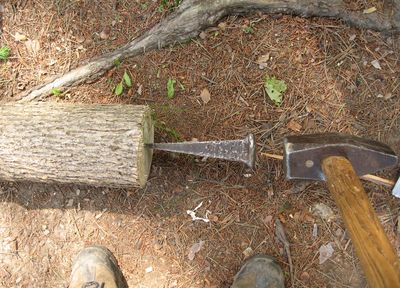 The pieces I was using were on the order of 1.5 meters (6') or longer.
So just putting them on the chopping block was not an option. I started
the split by driving a splitting wedge into one end of the logs.
The pieces I was using were on the order of 1.5 meters (6') or longer.
So just putting them on the chopping block was not an option. I started
the split by driving a splitting wedge into one end of the logs.
When the hydro people cleared out what had grown underneath the power lines over the years at my parents' place, I decided to try to split some much longer pieces for the purpose of later cutting into lumber.
 The pieces I was using were on the order of 1.5 meters (6') or longer.
So just putting them on the chopping block was not an option. I started
the split by driving a splitting wedge into one end of the logs.
The pieces I was using were on the order of 1.5 meters (6') or longer.
So just putting them on the chopping block was not an option. I started
the split by driving a splitting wedge into one end of the logs.
 With the splitting wedge driven all the way in, I started driving another
splitting wedge into the end of the crack to open that up some more.
With the splitting wedge driven all the way in, I started driving another
splitting wedge into the end of the crack to open that up some more.
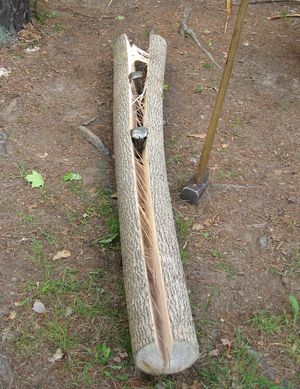 By driving the second wedge in, the end of the log opened up enough that I
could tap the wedge out with a hammer. And so I proceeded to
alternate the two wedges, working my way to the other end.
By driving the second wedge in, the end of the log opened up enough that I
could tap the wedge out with a hammer. And so I proceeded to
alternate the two wedges, working my way to the other end.
I tried to split the logs in such a way that the split lay mostly
in a plane. That is, I picked the ange at which I split the log such
that the curvature of the log would mostly lie within the plane I split it apart at.
That way, I'd end up with a surface that, though it was curved sideways,
was at least relatively flat.
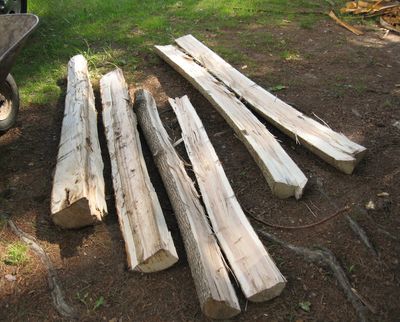 I split numerous logs. The white ash that I split went reasonably well,
but the maple and yellow birch were quite difficult to get apart, and didn't
split very cleanly. Overall, I'd say, after propagating the split by
1.5 meters from one end to the other, it just wasn't a clean line
of separation anymore.
Also, some of the logs had a slight twist in the grain, and the split followed
that instead of a straight line. It would have probably been better to start
with pieces only one meter in length or shorter to avoid getting too
much cumulative twist end to end.
I split numerous logs. The white ash that I split went reasonably well,
but the maple and yellow birch were quite difficult to get apart, and didn't
split very cleanly. Overall, I'd say, after propagating the split by
1.5 meters from one end to the other, it just wasn't a clean line
of separation anymore.
Also, some of the logs had a slight twist in the grain, and the split followed
that instead of a straight line. It would have probably been better to start
with pieces only one meter in length or shorter to avoid getting too
much cumulative twist end to end.
Sawing the wood apart, as opposed to splitting it, does have the advantage
that the cut is in a straight line, even if the grain is not.
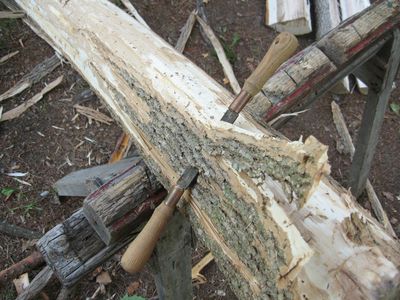 Next I de-barked the pieces. For the white ash, the bark came off best with
a drawknife. For the maple, I had to use a hatchet to get it off, which was
much more time consuming. De-barking the wood is important, as the bark often
contains bits of sand from when the trees were felled and logged. The bark
is also used by wood worms as a starting point to get into the wood, so
if you remove the bark, the worms can't get in while it's drying.
Next I de-barked the pieces. For the white ash, the bark came off best with
a drawknife. For the maple, I had to use a hatchet to get it off, which was
much more time consuming. De-barking the wood is important, as the bark often
contains bits of sand from when the trees were felled and logged. The bark
is also used by wood worms as a starting point to get into the wood, so
if you remove the bark, the worms can't get in while it's drying.
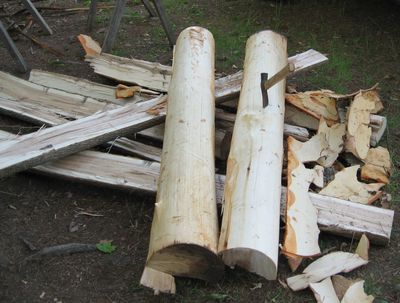 And here's my split and de-barked wood. It still needs a few years drying
time, and I still need to mill it into usable pieces. It's quite a lot of work
to go thru to get hardwood. Perhaps it wasn't the best use of my time, but
it is very satisfying making one's own lumber.
And here's my split and de-barked wood. It still needs a few years drying
time, and I still need to mill it into usable pieces. It's quite a lot of work
to go thru to get hardwood. Perhaps it wasn't the best use of my time, but
it is very satisfying making one's own lumber.
Now I just have to wait a few years for the wood to dry before I can use it. Very solid pieces do take a very long time to dry. I have been keeping some pieces in my hot attic over the summer to accelerate the drying a bit.
To turn the pieces of log into usable lumber, I plan on using the same method I used to get lumber from firewood